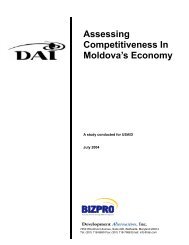Trade and Commercial Law Assessment - Honduras - Economic ...
Trade and Commercial Law Assessment - Honduras - Economic ...
Trade and Commercial Law Assessment - Honduras - Economic ...
You also want an ePaper? Increase the reach of your titles
YUMPU automatically turns print PDFs into web optimized ePapers that Google loves.
TRADE AND COMMERCIAL LAW ASSESSMENT DECEMBER 2004<br />
HONDURAS<br />
Insolvency proceedings in <strong>Honduras</strong> include three distinct proceedings: the concurso, or<br />
concurrencia, a consumer (or non-merchant) bankruptcy under the Civil Code; 86 quiebra, or<br />
merchant bankruptcies under the <strong>Commercial</strong> Code; 87 <strong>and</strong> suspensión de pagos, or merchant<br />
reorganizations under the <strong>Commercial</strong> Code. 88 As confirmed by the relatively small number of<br />
its articles on suspensión de pagos, the <strong>Commercial</strong> Code does not contain an extensively<br />
developed law for merchant reorganization through restructuring of debts. However, its<br />
provisions are open <strong>and</strong> flexible enough that they would permit an active <strong>and</strong> commercially<br />
savvy judge to oversee an effective reorganization.<br />
Both the Honduran Civil Code <strong>and</strong> the Honduran <strong>Commercial</strong> Code treatments of insolvency<br />
retain a vestige of classic bankruptcy law, the skeptical presumption—largely absent from<br />
modern insolvency statutes beginning in the mid 20 th century—that the debtor who cannot pay<br />
his or her debts is probably guilty of improper conduct. 89 The codes both provide for<br />
proceedings to determine the debtor’s degree of responsibility for the financial failure. The<br />
<strong>Commercial</strong> Code in particular includes rather extensive provisions for assigning blame <strong>and</strong> even<br />
criminal penalties in cases of merchant bankruptcy <strong>and</strong> imposes an obligation on the court to<br />
determine the degree of responsibility of those with administrative control of the debtor, ranging<br />
from “fortuitous” bankruptcies to “culpable” bankruptcies <strong>and</strong>, at the extreme, bankruptcies in<br />
which criminal fraud is present. 90<br />
1. Code of Procedures<br />
Promulgated in 1906, the Code of Procedures includes both civil <strong>and</strong> criminal procedures. Its<br />
civil section includes careful provisions for both consumer <strong>and</strong> commercial bankruptcies before<br />
the trial courts of general jurisdiction. 91 Specifically it provides for a debtor to turn over nonexempt<br />
assets to the estate administered by the court. 92 The court then gives notice <strong>and</strong> holds a<br />
meeting of all creditors to sort out claims against the debtor <strong>and</strong> to permit the debtor to propose<br />
to the creditors a plan for restructuring his or her debts, if he or she wishes to do so. 93 The court<br />
also supervises the appointment of a trustee in bankruptcy (síndico) to liquidate the debtor’s<br />
assets in favor of creditors’ proven claims 94 <strong>and</strong> presides over the determination of whether the<br />
86<br />
CC [Civil Code], Libro IV (De las Obligaciones y Contratos), Título XV (De la Concurrencia y Prelación de<br />
Créditos), Arts. 2244-2262.<br />
87<br />
CdCom [<strong>Commercial</strong> Code], Libro V (Quiebra y Suspensión de Pagos), Títulos I-V, Arts. 1318-1640.<br />
Nonetheless, the síndico, or bankruptcy trustee, may propose the continuation of the business instead of its<br />
liquidation, a form of reorganization under bankruptcy proper. CdCom, Art. 1357(III).<br />
88<br />
CdCom, Libro V (Quiebra y Suspensión de Pagos), Título VI, Arts. 1641-1674.<br />
89<br />
The term “bankruptcy,” derived from the Latin for “broken bench,” came from the medieval practice of<br />
breaking the insolvent merchant’s bench so that he could no longer carry on commerce in the marketplace.<br />
The same presumptive anathema attaches to the consumer who cannot pay his or her debts, although perhaps<br />
not to the same level. See CC, Art. 1442.<br />
90<br />
See CdCom, Arts. 1392, 1398-1421, 1628-1640 (stripping bankrupt merchants of their civil rights <strong>and</strong><br />
prohibiting them from engaging in commercial acts until <strong>and</strong> unless they are “rehabilitated,” either by a finding<br />
that the bankruptcy was “fortuitous” or by repayment of all debts in the case of “culpable” or “fraudulent”<br />
bankruptcies).<br />
91<br />
Código de Procedimientos (CdProc), Libro III (De los Juicios Especiales), Título II (Del Concurso de<br />
Acreedores), Arts. 524-644, <strong>and</strong> Título III (De los Procedimientos de la Quiebra), Arts. 645-654.<br />
92<br />
CdProc, Arts. 536-537, 588-592.<br />
93<br />
CdProc, Arts. 538(2), 543-556, 567.<br />
94<br />
CdProc, Art. 569.<br />
VIII-8

















